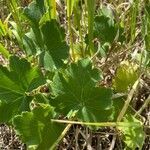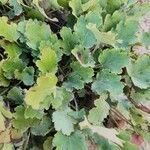Herbs acaulescent; caudex branched. Flowering stems (7-)20-95 cm, densely long stipitate-glandular. Leaves: petiole densely or sparsely long or short stipitate-glandular; blade broadly ovate or cordate, deeply 5-7-lobed, 2.5-10 cm, base cordate or nearly truncate, lobes rounded, margins dentate, apex acute, surfaces long stipitate-glandular abaxially, glabrous or long stipitate-glandular adaxially. Inflorescences dense to diffuse. Flowers: hypanthium strongly bilaterally symmetric, free 2-7 mm, green, campanulate, abruptly inflated distal to adnation to ovary, 5-14 mm, short stipitate-glandular; sepals erect, green-tipped, equal, 1.3-4.2 mm, apex rounded (sinuses wider than petals); petals erect, green or greenish white, rarely pink, narrowly spatulate, unlobed, 1.3-4 mm, margins finely dentate or coarsely fimbriate; stamens 1.5 mm included to 4 mm exserted; styles from 0.6 mm included to 0.3 mm exserted, 4-6 mm, to 0.1 mm diam. Capsules ovoid, 7-14.5 mm, beaks divergent, not papillose. Seeds dark or very dark brown, ellipsoid, 0.6-0.9 mm. 2n = 14, 28.
More
Plants 2–9 dm; scape with a few small, scale-like bracts; petioles strongly spreading-hirsute; lvs broadly cordate-ovate, glabrous or nearly so above, hairy at least on the veins beneath, shallowly 7–9-lobed, each lobe with 3–5 rounded to acute, mucronate lobules; stems ± hirsute, becoming glandular above; infl relatively narrow and congested; fls very oblique, 7–10 mm on the upper side, half as long below, with wide sinuses between the sep; free part of the hypanthium 2–6 mm; pet mostly green or greenish-white (pink), 2–4 mm, narrowly spatulate, finely toothed; stamens shortly included to long-exserted; style shortly included to shortly exserted; 2n=14, 28. Prairies and dry woods; s.c. Mich. and nw. Ind. to nw. Ark. and ne. Okla., w. and n. to Colo. and Alta. May–July.



